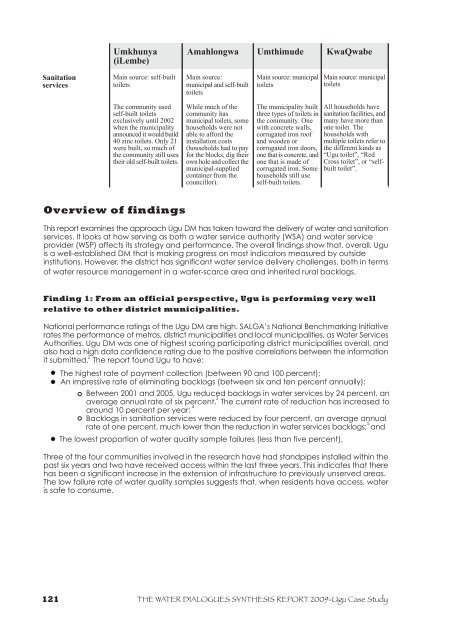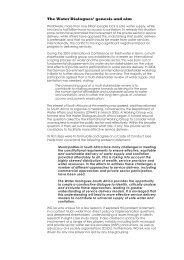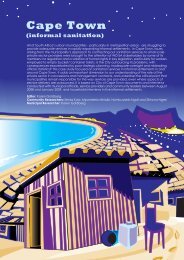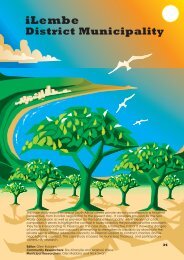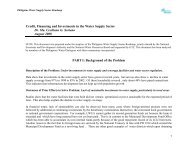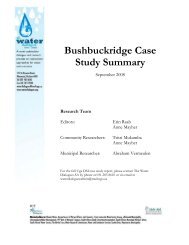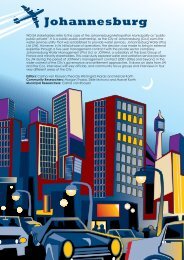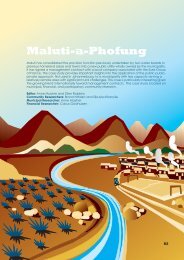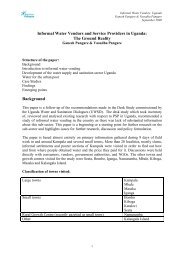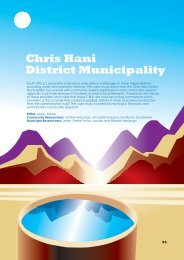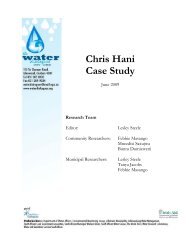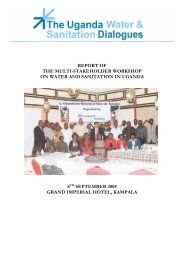Ugu Case Study Summary - The Water Dialogues
Ugu Case Study Summary - The Water Dialogues
Ugu Case Study Summary - The Water Dialogues
You also want an ePaper? Increase the reach of your titles
YUMPU automatically turns print PDFs into web optimized ePapers that Google loves.
Umkhunya Amahlongwa Umthimude KwaQwabe<br />
(iLembe)<br />
Sanitation<br />
services<br />
Main source: self-built<br />
toilets<br />
Main source:<br />
municipal and self-built<br />
toilets<br />
Main source: municipal<br />
toilets<br />
Main source: municipal<br />
toilets<br />
<strong>The</strong> community used<br />
self-built toilets<br />
exclusively until 2002<br />
when the municipality<br />
announced it would build<br />
40 zinc toilets. Only 21<br />
were built, so much of<br />
the community still uses<br />
their old self-built toilets.<br />
While much of the<br />
community has<br />
municipal toilets, some<br />
households were not<br />
able to afford the<br />
installation costs<br />
(households had to pay<br />
for the blocks, dig their<br />
own hole and collect the<br />
municipal-supplied<br />
container from the<br />
councillor).<br />
<strong>The</strong> municipality built<br />
three types of toilets in<br />
the community. One<br />
with concrete walls,<br />
corrugated iron roof<br />
and wooden or<br />
corrugated iron doors,<br />
one that is concrete, and<br />
one that is made of<br />
corrugated iron. Some<br />
households still use<br />
self-built toilets.<br />
All households have<br />
sanitation facilities, and<br />
many have more than<br />
one toilet. <strong>The</strong><br />
households with<br />
multiple toilets refer to<br />
the different kinds as<br />
“<strong>Ugu</strong> toilet”, “Red<br />
Cross toilet”, or “selfbuilt<br />
toilet”.<br />
Overview of findings<br />
This report examines the approach <strong>Ugu</strong> DM has taken toward the delivery of water and sanitation<br />
services. It looks at how serving as both a water service authority (WSA) and water service<br />
provider (WSP) affects its strategy and performance. <strong>The</strong> overall findings show that, overall, <strong>Ugu</strong><br />
is a well-established DM that is making progress on most indicators measured by outside<br />
institutions. However, the district has significant water service delivery challenges, both in terms<br />
of water resource management in a water-scarce area and inherited rural backlogs.<br />
Finding 1: From an official perspective, <strong>Ugu</strong> is performing very well<br />
relative to other district municipalities.<br />
National performance ratings of the <strong>Ugu</strong> DM are high. SALGA’s National Benchmarking Initiative<br />
rates the performance of metros, district municipalities and local municipalities, as <strong>Water</strong> Services<br />
Authorities. <strong>Ugu</strong> DM was one of highest scoring participating district municipalities overall, and<br />
also had a high data confidence rating due to the positive correlations between the information<br />
2<br />
it submitted. <strong>The</strong> report found <strong>Ugu</strong> to have:<br />
<strong>The</strong> highest rate of payment collection (between 90 and 100 percent);<br />
An impressive rate of eliminating backlogs (between six and ten percent annually):<br />
Between 2001 and 2005, <strong>Ugu</strong> reduced backlogs in water services by 24 percent, an<br />
3<br />
average annual rate of six percent. <strong>The</strong> current rate of reduction has increased to<br />
4<br />
around 10 percent per year;<br />
Backlogs in sanitation services were reduced by four percent, an average annual<br />
5<br />
rate of one percent, much lower than the reduction in water services backlogs; and<br />
<strong>The</strong> lowest proportion of water quality sample failures (less than five percent).<br />
Three of the four communities involved in the research have had standpipes installed within the<br />
past six years and two have received access within the last three years. This indicates that there<br />
has been a significant increase in the extension of infrastructure to previously unserved areas.<br />
<strong>The</strong> low failure rate of water quality samples suggests that, when residents have access, water<br />
is safe to consume.<br />
121<br />
THE WATER DIALOGUES SYNTHESIS REPORT 2009-<strong>Ugu</strong> <strong>Case</strong> <strong>Study</strong>


